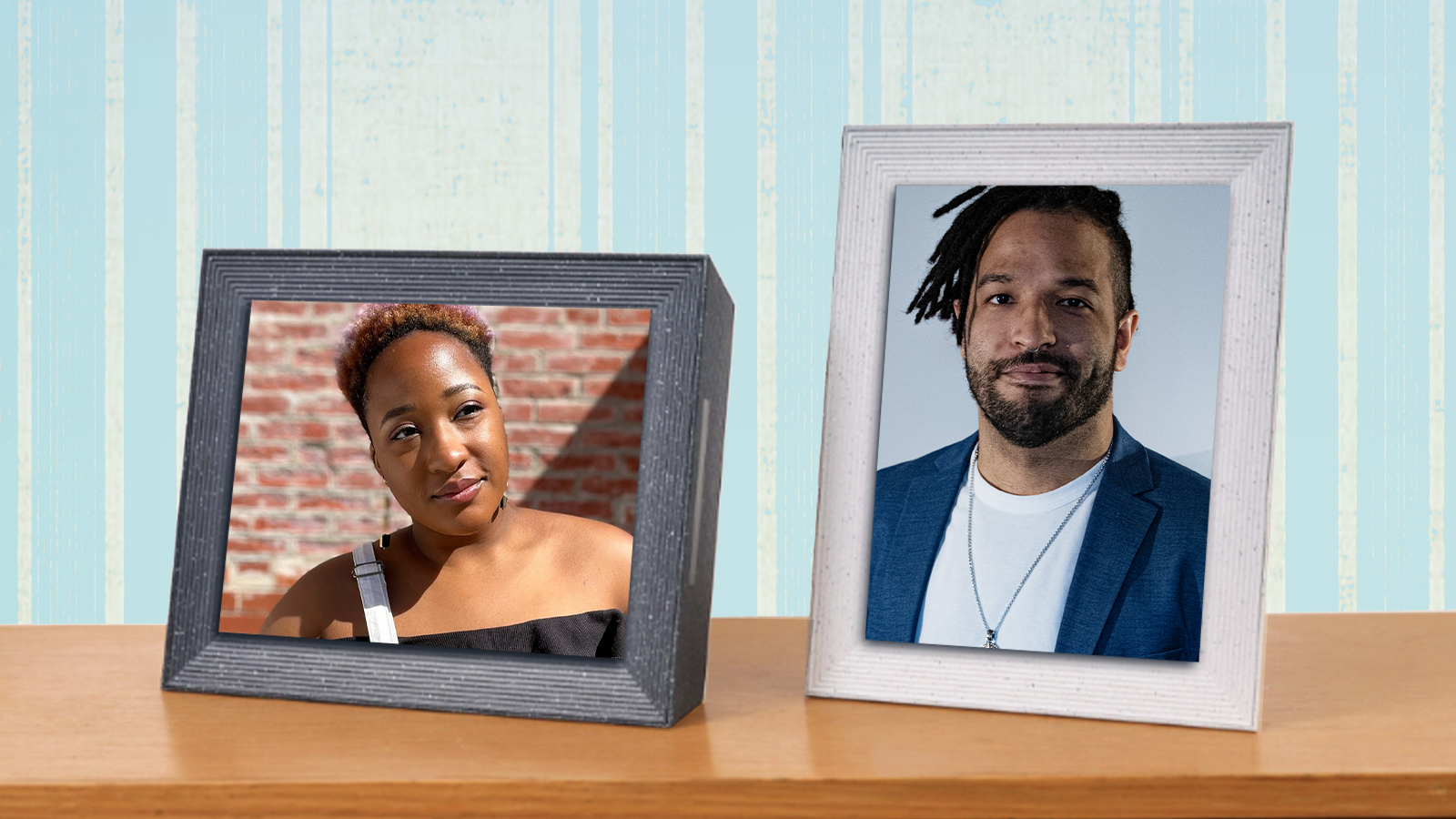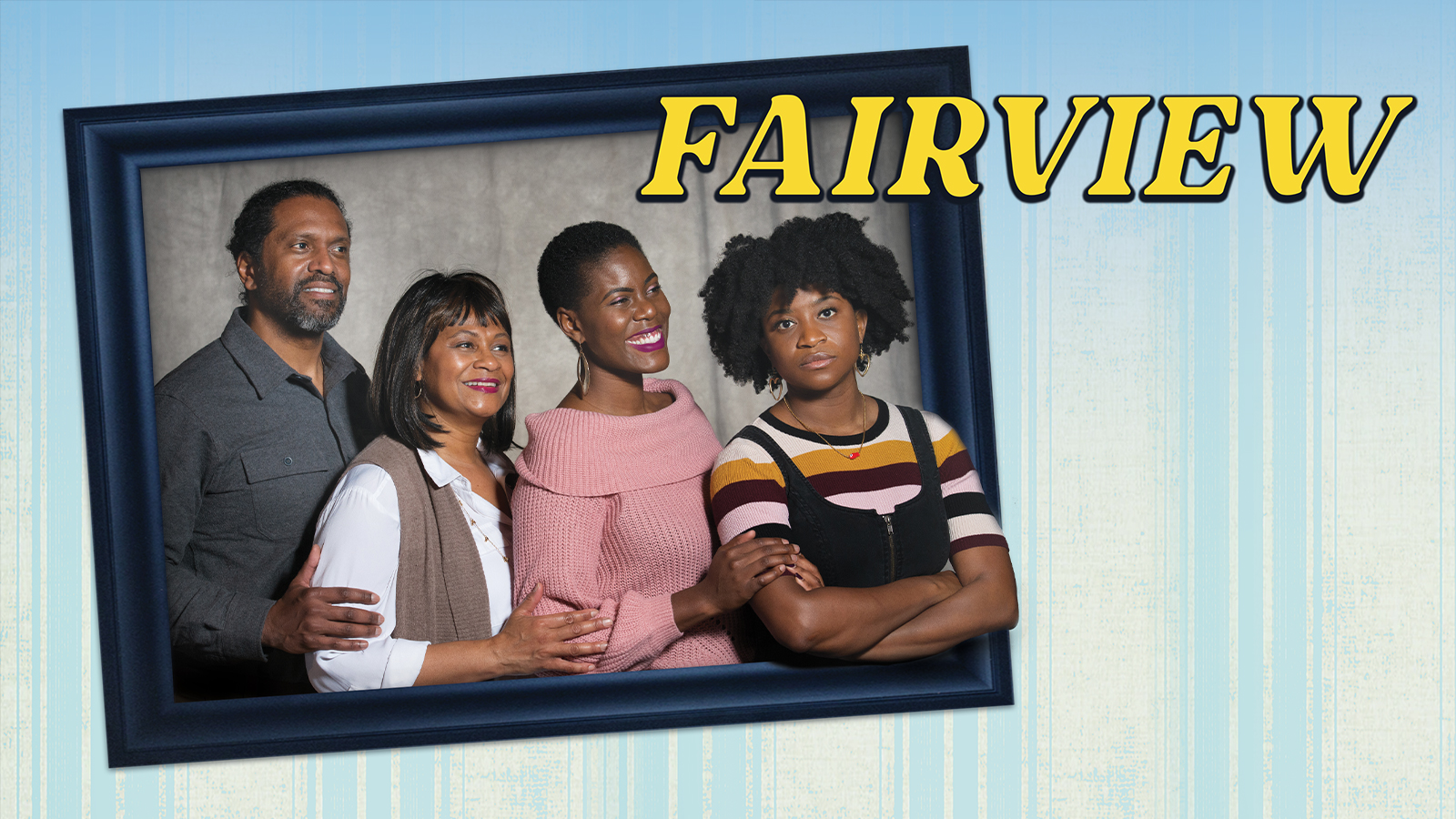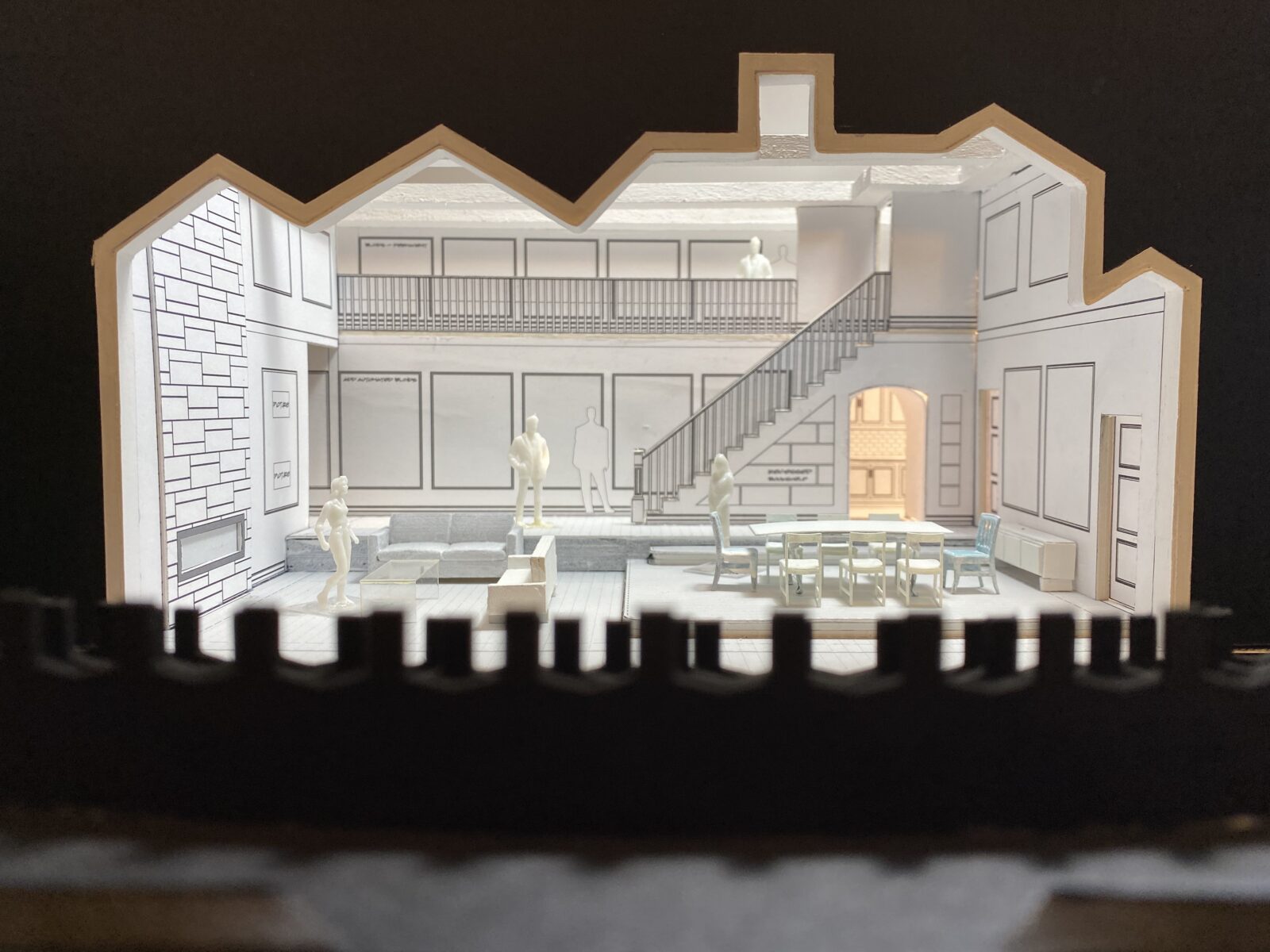

May 24, 2022
Fairview, the Pulitzer Prize-winning play by Jackie Sibblies Drury, is a play about a Black family, with a twist. What feels like a recognizable TV comedy begins to shift, and through the course of the play we discover it is more about American views and perceptions of race and identity.
Mariah Ghant (that’s me!) Wilma Theater Artistic Administrator and Dramaturg for this production, spoke with Scenic Designer Lawrence Moten to hear how his vision and design tie in the many themes and underlying currents of Drury’s play.
Mariah: Hello! It’s super nice to virtually meet you. I’ve heard amazing things, and I’m really glad to have you on this project. I can’t wait to meet you in person, hopefully in the coming weeks.
Lawrence: I mean, I’m supposed to be there on what, the 24th for the start of Tech, so we’re… Twelve days away?
For the non-theater-inclined folks, “Tech” is the time when all the pieces start to come together. The director and performers are joined by all the crew members and designers, and they spend time going through the show, moment-by-moment, layering in all of the design elements with the performing! It’s a magical (and slightly maddening) time!
Mariah: This project is something that I’ve been looking forward to this whole season, and for it to be– it’s happening? It’s tangible?? It’s very hard to believe at times! But anywho, thank you so much for doing this! I’ll say this upfront: Something we’re toying with through dramaturgy and marketing for audiences ahead of time is how much we can tell them without giving too much away. So keep that in mind with some of these questions, too, and your responses.
We both share a laugh, knowing it is not THAT easy.
So, with that! The most basic question: Can you tell me a little bit about yourself?
Lawrence: Sure. My full name is Lawrence Eugene Moten III. (There’s a very famous Lawrence Moten who is an NBA basketball player. It’s why I don’t have Lawrencemoten.com as my website! Haha.) I’m based in Brooklyn, New York. I’ve been living in New York for the past 10 years. Now it’s my ten year anniversary.
Mariah: Congrats!
Lawrence: Thank you so much. I am primarily a scenic designer, a proud member of local USA 829. I came to scenic design by way of great high school educators! I moved to Texas when I was 13 with my mom. And being the brilliant woman that she is, my mom said, “I would like you on the cross country team, and I’d like you to take a theater class.” Fast forward to the next year, at 15 years old, I was like, “This is what I want to do with the rest of my life.” And I figured that out through Texas. Right? Wild thing! I had these three theater teachers, and they were giving everything they could to inspire the high schoolers who hadn’t necessarily been given an opportunity to look beyond their current surroundings. And that doorway opened to me. And here I am 15 years, 16 years later, having just made my Broadway debut in October, having worked on world premieres and new play development for years and loving all of that. So my start is there.
Mariah: Similarly, I owe every bit of theater love that I have to my high school teacher, and she is somebody who also became a really good friend.
So, next question: Like you just said, you had your Broadway debut with Chicken and Biscuits. I feel like a lot of your work centers around things that are so central to the Black experience. So, I’m curious about where you draw inspiration from and what fuels you.
Lawrence: Yeah. I think the easiest statement is to say sculpture. I don’t necessarily think of myself as an interior decorator, which is what so many people think about set design. I consider myself a sculptor of space, a sculptor of energy. My research starts in abstraction. What is something that feels like it resonates with the underlying energy of the words of the text– always going back to the words of the playwright and then figuring out how that energy is embodied and held or stopped or energized. I’m also going to say fully and wholeheartedly that in my practice, having been raised and taught in a white colonialist society, I am learning how to make sure that for at least half of my work I’m going to find those artists who do not ascribe to a Eurocentric narrative. Where are the artists who are largely marginalized, who don’t get the ups, who don’t get the hits, and how do I start to engage that work and be inspired by that artistry so that then influences the work down the road? But without actively working that antiracist lens, my work would suffer. And my work feels fuller and deeper and wider because of it.
But abstraction! That’s where it starts.
Mariah: So, this idea of abstraction, how has it been working for you in designing Fairview, specifically? I’m curious about the ways that you’ve been utilizing that lens.
Lawrence: I think it comes down to the idea of “The Reveal.” And we’ll stop there.
We share a chuckle and a look.
For audiences, there is some version of a reveal that happens throughout the course of the play. And I think it was a conversation with James to figure out how we abstract that moment and lean into the theatricality that Jackie has given us in the text. Abstraction doesn’t work until you understand what the bones of reality are so that you can move around them. And so in thinking about Fairview and the socio-economic status of this family, how wealthy they ultimately are, we started by looking at houses and living spaces that were wildly real, that were wildly cemented in reality and then taking them to a level of abstraction. “McMansions” are where we started.
Mariah: I’m a reality TV nut, and James constantly is talking about how these are the Real Housewives of Atlanta. Like, this home is that kind of a McMansion vibe. So that always resonates with me! In rehearsal, James was like, “Oh, over here is a sunken living room.” And one of the actors goes, “Ohhhh! So they got money!” We both laugh

Ok. Next Q! What was your first interaction with Fairview? You said you’re someone who goes back to the playwright and the text constantly, so tell me about that first time you experienced this story.
Lawrence: So it’s really interesting. My spouse worked on the original production.
Mariah: Oh, no way!
Lawrence: And at the time I was like, I got asked to do Fairview, and she was just like, “Ohhhh, I worked on that at Soho Rep. That show is a lot.” And I was like, okay, don’t tell me. But she, a theatrical designer, knew that I needed to read the thing for the first time and kind of sit with it. I was like, okay, I’ve got some time. I need to read this play to be ready to have a conversation with James. And I remember reading it and I was sitting in our hotel room, and I just turned to her and I said, “What the fuck? Honestly!!!?”
We both laugh. A sentiment I also shared when reading the play.
I think I was so blown away and so caught off guard by the places that Jackie asks us to go and the things that she asks not only of the play, but of ourselves. What are those self-analytical moments? What are those really dark, deep, true conversations that are had totally in private or in the most trusted companies that can be really raw, that can be really hard? And how do we let those things live in the space and ask performers and creatives and storytellers to kind of honestly and vulnerably engage? That was where I was after reading it.
Mariah: Oh, my God… I keep having this, too, with friends where they know a little bit about the story, but not everything. And I keep going back and forth about how much to share. It’s a lot to take on, but it is what the playwright is asking of us. It’s what the play is asking of us. And to get everything out of [the play], it’s crucial to have that experience of going in and living through it.
You started talking about you and James and your development together. What were some of your early conversations like? What really sparked for you and made you excited about the project?
Lawrence: It was really interesting because I think I relate most closely to the version of family that we see in Act One.
Mariah: Yes. Right. The “Sitcom Family”.
Lawrence: Yes! My parents didn’t have a lot growing up. My father went into computers and he was in the “.com” kind of bubble. And I remember our family kind of got a lot of wealth really quickly and then lost a lot of wealth really quickly in the bubble burst. And so there’s a version of, like, wealth that is adjacent to whiteness that is about assimilation that I understand intrinsically because I was raised to be an assimilationist. And so I was wildly intrigued at how to take that and push it. What is this version of wealth that is specifically black, but kind of not? How is this a family that knows its positional power and needs and wants to identify as black but wants to be accepted in a power structure that is inherently white?
Mariah: In the second act, there’s a conversation about blackness and…
I pause, struggling to put my words together.
Oh, I’m trying not to give too much away. It’s so hard! But some of the characters discuss how money applies to blackness and, like, how being rich maybe doesn’t align with something in the play they refer to as “the full Black experience.” And I think about that constantly with this first act. How has this been ingrained into our way of thinking that it’s just so intrinsic?? It’s just… Jackie! She makes your brain hurt a little bit!
Lawrence: Makes your brain hurt a little bit. It’s really good!
I think the world is going to feel weirdly too much, and that’s the point.
Fairview Set Designer Lawrence E. Moten III
Mariah: Ok so, another theme that we talk about quite often in the room is this idea of surveillance and being watched. It’s so crucial to what inspired Jackie to write this play. As the scenic designer, how has that played into your work with this set specifically, if at all?
Lawrence: I think this idea of surveillance kind of went super deep and unconscious because to hear you say it out loud, I was like, “Oh, of course I did that!” I put them in a glass house. For people who are going to come see the show, there’s this giant wall of windows that exists in the design that we can’t see through– until we can. There’s a level of distance until there isn’t. That lets us know we are a fly on the wall observing an entirely private action that is not meant to be seen. It lets us know that this is a family under constant observation. I think there was this level of being interested in what it was to have this giant bay of windows that were obscured and what happens when they’re unobscured. James landed on that connection between wealth and windows and surveillance and instantly was like, “That’s the thing!”
Mariah: Oh, that’s so cool to hear how all of those pieces came together. And a bit subconsciously too! James has a great way with vision. He can see and hear things and then, BOOM, just tie it all together.
So, is there anything that I didn’t ask about that you maybe want to sprinkle in in these last couple of minutes?
Lawrence: What I think people are going to be really intrigued or confused about if they know my body of work is how “bland” this space is gonna be. Even in the research that I went into in the world of McMansions, something that James and I have said multiple times is “beige on beige on beige on beige.” So how do you have variations on a theme that’s become so overblown that it’s tasteless?
Mariah: (A silent squeal.) That’s it! That’s it! Sorry!
Lawrence: I think the world is going to feel weirdly too much, and that’s the point. But in the world of “beige on beige on beige on beige,” what we’re really asking is, “How do you take a motif and then drive it into the ground so that it becomes almost suffocating?” And I don’t have all the answers yet. One of the things I love about Tech is that I’m going to go in with this team and figure out the world with the performers because there’s a physicality that they have to live in that I have to support. So, I lay the framework.
Mariah: That’s beautiful! Well, I think that’s everything that I had. Again, I’m so excited to see this come together. And thank you so much! You’re incredibly insightful.
Lawrence: Absolutely. Glad I could do it.